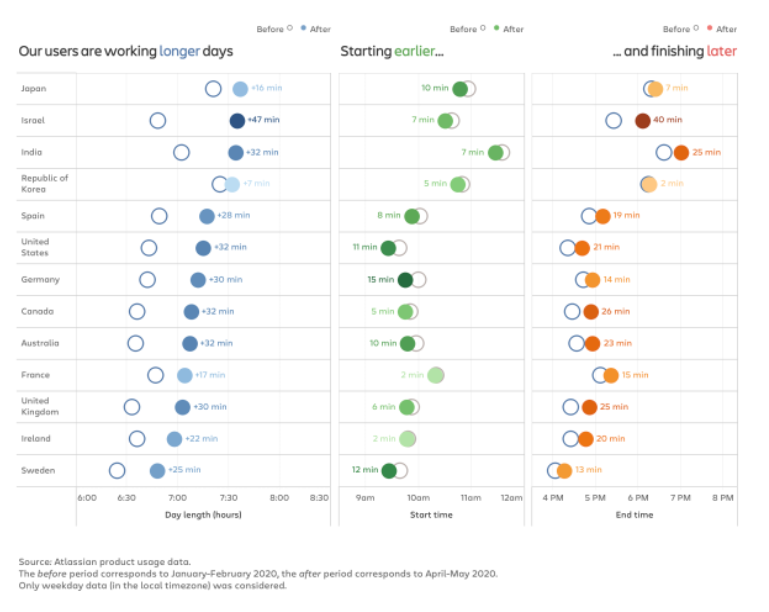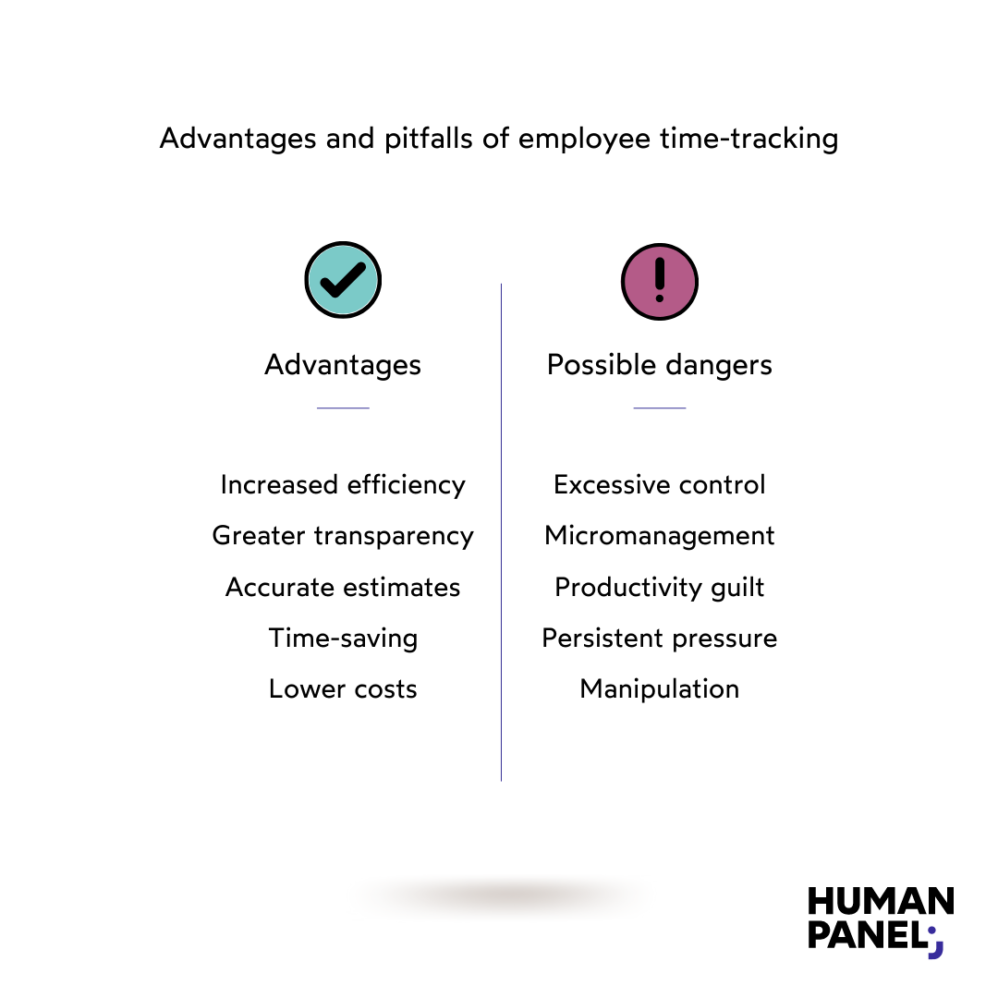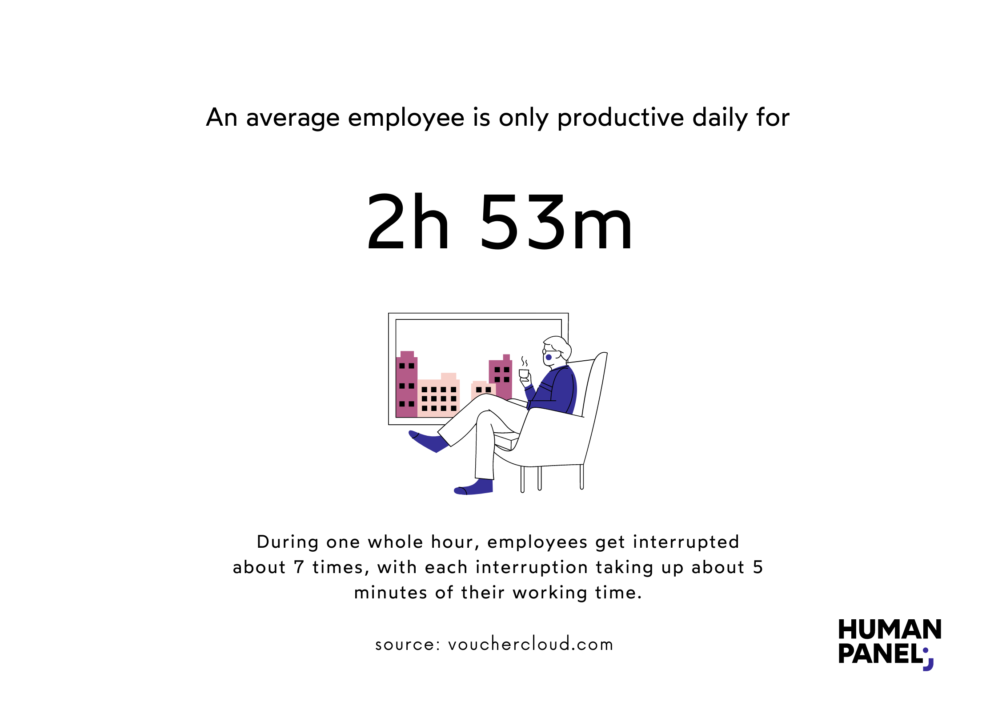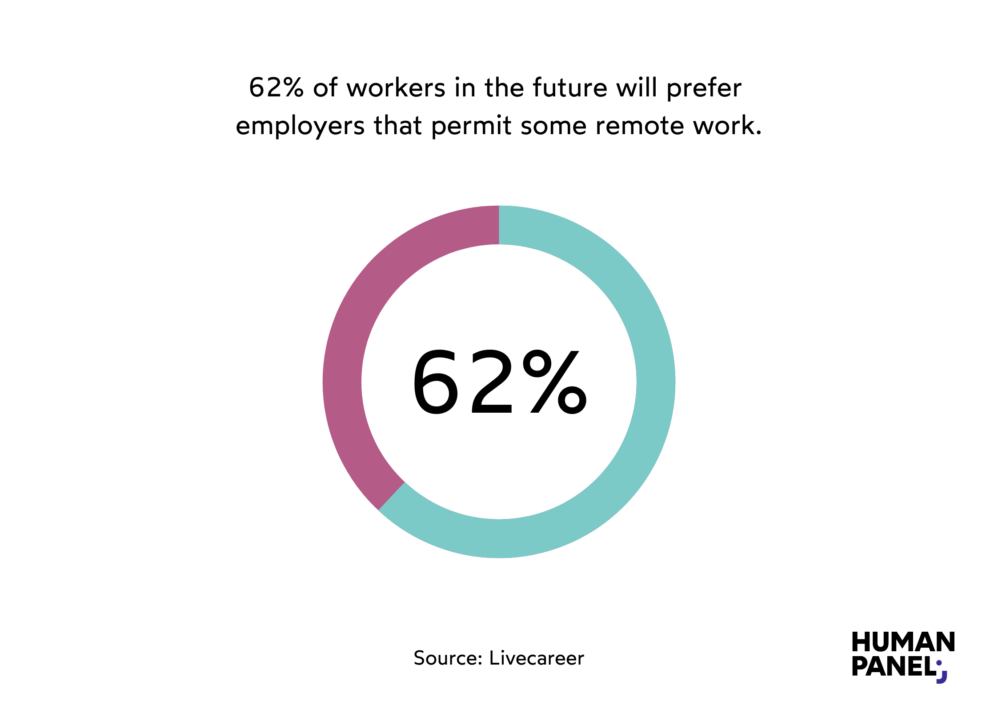Remote work productivity statistics – what do they tell us?

How do you know you’re not falling into the trap of false efficiency? Here’s how to see the truth behind the numbers about productivity of people working remotely.
A recent survey stirred up HR professionals on Twitter and LinkedIn. It was conducted by researchers at the University of Chicago and investigated the productivity trends of 150,000 employees at a large IT service company. It also provided a partial answer to a question that has been on everyone’s mind: “is working from home more productive than working in an office?” Here are the results:
| Location | Hours worked per day | Output | Productivity |
| Office | 5.08 | 100.82 | 1.36 |
| Home | 7.04 | 100.30 | 1.11 |
Source: University of Chicago/tomtunguz.com
The data shows that employees who worked from home achieved the same results but spent more time on their tasks than in the office. So the productivity of this company decreased. Further research revealed that employees who work from home spend more time working after hours, email, and meetings.
Another study from Atlassian proves that the number of hours worked in 2020 for the average employee increased by more than half an hour. It shows that the Atlassian users answered emails and messages, tracked tasks in Jira, and logged into Confluence outside of their regular work hours. They also started work earlier and finished later. And this was not just a local trend – Atlassian researchers gathered findings from 65 countries.

While the data here isn’t strong enough to prove any regularities, the talk around productivity has peaked. But why has productivity become the Holy Grail of today’s workforce? And why can measuring productivity be misleading? Let’s dig into the topic a little deeper.
What is productivity?
First, let’s define what productivity means.
Productivity is usually defined as the ratio of the volume of output to the volume of inputs. Historically, it comes from the Industrial Revolution, when people moved from fields to factories and their employers needed to determine the desired number of goods or services produced in a given time.
Much of this approach has survived until today. We believe that better time management leads to increased productivity and, consequently, greater output from the same amount of input. If, for example, a sales team meets or even exceeds its productivity goals, it shows to the outside world that it performs well.
“This is the first trap of productivity assessment, because the higher output doesn’t have to mean that a team functions well” comments Daniel Aduszkiewicz, the CEO and Co-Founder of Human Panel. “We would need additional data on the quality of work and the well-being of the team,” he adds.
Productivity at home vs. in the office
Regarding the data from Atlassian and the University of Chicago, you might be surprised that about half of employees who work from home say they are more productive. Sixty-two percent of employees will prefer employers who allow some remote work in the future. Twenty-nine percent would quit if they were not allowed to work from home.

Why then do we spend more time and work longer hours while working remotely?
Several reasons explain such behavior, and one of them is the “who works the most” race.
Before the pandemic, employees showed their commitment by spending more time at their physical desks in the office. Now, they have switched to online communicators and make sure that the word “available” is always visible with their name.
The idea is, “If everyone is still working, then I have to do this too.” Before the pandemic, some companies had an unofficial policy of “you do not leave before your boss.” But even during the lockdown, 54% of UK workers felt obliged to physically come to the office – especially those in early and mid-career.
The presenteeism trap
This urge for presenteeism has been around for years and it intensified during the Covid 19 crisis. When employees fear for the stability of their jobs, they want to prove their worth. And their supervisors still tend to favor those “who have the time to show up early and leave late.”
“Some employees use this strategy because they think greater “visibility” will lead to a faster promotion,” says Daniel Aduszkiewicz. He adds that we have over 200 different biases as humans, one of which is the “exposure effect.” If you see a person ten times a day, you will naturally like them more. If you see “a green light” next to someone’s name at an online communicator, you will feel that this person “works more”.
Another bias is the “halo effect,” which means that you associate positive impressions of someone with their actual character. “If someone brings you coffee every day and asks you about your plans for the weekend, you are more likely to think he or she is a hard worker, too,” adds Leigh Thompson, professor of management and organizations at Northwestern University’s Kellogg School of Business, US.

Setting productivity goals
Another problem with productivity is that many business leaders set goals without thinking more deeply about what should be behind the numbers – and the problem emerges at scale.
If you’re running a large company, it’s easy to translate a 1-percent productivity increase into revenue and that’s a tempting option. Some companies measure, for example, how quickly their customer service representatives respond to customer calls and try to optimize the process. But again, you should always look at the big picture, especially if the team is not meeting the goals.
“When you identify and understand all inefficiencies, you work smarter. If your team isn’t delivering the results you want, maybe it’s because of poor tools? Think of the different productivity levels across countries: some are always higher on the list than others. It’s popular to explain those differences by cultural context (nation X is lazy while nation Y is hard-working) but maybe there’s also a different level of automation in those countries?
That’s why it’s always worth digging deeper and gathering more data points. The more data we collect, the more layers we see, and the more comprehensive conclusions we can draw,” says Daniel Aduszkiewicz.

An easy path to burnout
The constant need to increase efficiency and drive for increased productivity can be dangerous and lead to more stress, pressure and feeling of guilt. We naturally believe we have the skills to take on more and more and feel the need to justify how we use our time. But when we put too much pressure on ourselves, it’s an easy path to a burnout.
So what can you do to avoid productivity guilt yourself and keep your employees from experiencing it? There are three essential steps you can take.
1. Look into the data
The first thing you can do is look at the raw performance data of your workforce provided by people analytics solution. What are your teams working on? Are they working long hours to achieve their goals? Are they delivering the expected results?
“A detailed data analysis and the right questions will give you an overview of the state of your workforce and projects. If you notice that a team is not meeting goals despite working long hours, you can respond adequately. You will be able to understand the causes of these inefficiencies and make the right decision,” says Daniel Aduszkiewicz.
Also, people analytics will show you who got a promotion or a raise. This way, you can eliminate personal biases that influence employee decisions. Maybe a single mom who always leaves early is just as productive as someone who stays late to be “available” on Slack?
2. Give an example
The other solution to a potential productivity debt is to model healthy behavior. If you are a manager, you should set an example for your team. As soon as you finish your work, leave. Log off. Do not be chained to your desk and computer. Employees who work long hours usually pressure others to do the same, which leads to a vicious circle.
It might be challenging because managers and bosses have their bosses, too – and might themselves be under pressure to be productive and always present. But do not let yourself become a slave to presenteeism and imagined expectations. When in doubt, look at the data again – it will help you determine whether your meeting your goals.
3. Use time-tracking tools wisely
Some employers have adopted employee time tracking to maximize efficiency. And while it’s sometimes essential to running the business, it can also provoke disruption and lead to excessive control. Therefore, you should first consider what problem you want to solve before implementing a time-tracking solution in your business.
Pros of time tracking
Let’s look at some of the pros and cons of employee time management. We list some advantages below.
Increased efficiency
Time tracking helps employees focus on their tasks, avoid multitasking and distractions, which can eat up to 40% of our overall efficiency.
Greater transparency
With many employees working remotely today, time tracking can give managers better insight into who did what and how much time they spent on work.
Accurate estimates
The data collected by time tracking software can serve as a basis for cost and time estimates for future projects, helping avoid potential discrepancies between estimates and invoices.
Time-saving
Manual completion of timesheets by employees can be time-consuming – both for the employees and those supposed to analyze the data. Time-tracking software does away with the need for manual data input.
Lower costs
Time tracking software can help you manage your billable and non-billable hours and eliminate “leaked hours.”

Dangers and pitfalls of time tracking
However, time tracking can have its downsides, the first and foremost of which is the feeling of excessive control. Employees whose work is tracked may feel that they are being spied on and that their supervisors do not trust them – primarily if a new policy is poorly implemented.
Extreme examples of time management and work-life monitoring are most prevalent in Asia. In the Chinese market, the big tech companies are introducing productivity-enhancing technologies in cut-throat competition. Some of them can be unethical, burdening workers with more stress. And while they increase efficiency, the actual cost comes at the expense of people’s well-being or even their lives.
Another danger of extreme time management is what is known as “productivity guilt”. It’s a constant need to accomplish more and see more significant results, even though goals and tasks are routinely achieved. Although this is a natural human tendency, it can create persistent pressure and affect mental health in its extremes.

The bottom line on productivity and time tracking
But behind the pros, cons, and dangers of time tracking lies something else – namely, why you want it in your business.
“Before you implement a time-tracking solution, you need to know what problem you’re trying to solve,” says Daniel Aduszkiewicz, the CEO & Co-Founder of Human Panel. “If you want to increase productivity, time tracking is not the only solution. While it can be an excellent business decision, you should first look at the data and decide what you want to accomplish and why,” Daniel Aduszkiewicz adds.
To reliably assess the efficiency of your teams, you should collect many different kinds of information. Some examples are time spent on a project, cost, billable and non-billable hours, customer score, and NPS (Net Promoter Score).
“All this information can help you build a data network around employee performance and productivity. In the long run, it will help you find better talent, build better teams, and align them with your customers’ needs,” Daniel adds.

Communication is key
However, if you do decide to implement time tracking, there’s one crucial area you need to address: communication.
“Time tracking may be obvious for your business because you have a law firm, and your employees are primarily billable. But if your business is shaped differently, introduce the change with the utmost transparency. Explain the point of your decisions to employees – whether it’s to get a better idea of workflow, increase transparency or reduce micromanagement,” says Daniel Aduszkiewicz.
Also, allow the trust to build with new tools and don’t take the first weeks’ data very seriously. Wait until you have credible results. “If you are running a large organization with more than 200 employees, I would advise against forming judgments in the first few months, as the data can be misleading,” adds Daniel Aduszkiewicz.

Conclusion
While productivity is one of the most critical metrics for any business, it should always be considered in context, as pure numbers can be misleading. The constant compulsion to increase productivity can be a trap, especially for businesses that operate on a larger scale. When comparing home and office productivity, always consider whose work is being analyzed. Only then will you discover the truth behind the numbers.
There are ways to avoid pitfalls and misconceptions and being a data-driven organization is one of them. Measuring the performance and productivity of your team is crucial to having a motivated and engaged workforce. If you understand the power of data, you might be surprised by the insights that people analytics brings you. To see how it works and what value it can bring to your company, sign up for a free demo.




